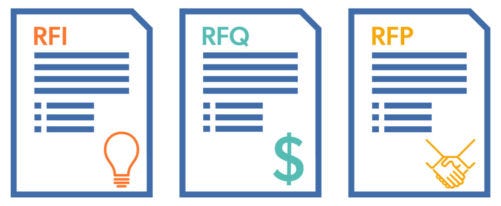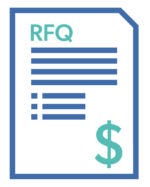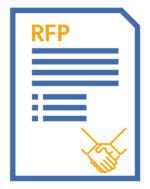What are the differences between an RFI vs RFQ vs RFP? While they may seem similar, a request for information (RFI), a request for quotation (RFQ) and a request for proposal (RFP) all have different definitions and serve different purposes within the procurement process. So how do you decide which RFx document you should use? It all comes down to what you’re trying to accomplish.
The difference between the RFI, RFQ and RFP is what information they provide:
- An RFI educates — RFI responses explore how a vendor might solve a problem or fill a need
- An RFQ quantifies — RFQ responses provide the cost of meeting a specific need
- An RFP compares — RFP responses evaluate the merits of each vendor compared to others
But that’s just the beginning. In this article we’ll explain how RFIs, RFQs and RFPs are related, how to select the right one, the purpose of each document, how to write them and examples of each.

How are RFIs, RFQs and RFPs related?
RFIs, RFQs and RFPs are often used in combination with one another or independently. Sometimes you’ll need to start with a request for information to better understand your market, and then with that knowledge you may move to issue an RFQ or RFP. Each is a different tool, so which do you use?
According to Kevin Iwamoto, senior consultant at Goldspring Consulting, “All three have been used globally for decades to obtain relevant information from potential suppliers and are meant to create and establish a fair and equal weighted process where all vendors, incumbent and potential, have a chance to become a ‘preferred’ supplier for a corporation. They have been instrumental in enterprise risk mitigation, process standardization, cost savings and cost avoidance.”
The core purpose of each type of RFx document is to help select the perfect vendor. To select the perfect vendor, To do that you need answers to your critical questions, but how do you ensure you ask the right questions? It often comes down to whether you should issue a request for information (RFI), request for quotation (RFQ), or request for proposal (RFP).
What are you trying to accomplish with your vendor request?
RFPs, RFIs, and RFQs have very distinct purposes. So your first step is to clearly establish what you’re trying to achieve.
Start by answering these questions:
- Do you know what questions to ask a vendor?
- Are your questions very specific or more general?
- Do you already have a preferred vendor list (a shortlist)?
- Do you need to bid out the work through a formal RFP process?
- Are you working with repeat or first-time vendors?
- Do you know exactly what you’re looking for, or would you like vendors to make suggestions?
You should also have an internal discussion to get answers to these questions. Find additional RFP questions to ask your team in order to avoid setbacks down the road.
RFI vs RFQ vs RFP comparison
Request for information — RFI
Purpose: When you’re looking for information or you’re not sure what solution might solve your problem
Asks: General questions designed to educate and inform
Style: Casual, asking for help
Advantage: They’re fast and help inform next steps to meet business needs
Request for quotation — RFQ
Purpose: When you know exactly what you want and why, but need to explore all of the financial details
Asks: Questions about what it will cost to meet the requirements
Style: Structured and prescriptive
Advantage: Removes distractions and allows buyers to focus on price
Request for proposal — RFP
Purpose: When you’re ready to shop around and evaluate many factors before making a choice
Asks: Specific, detailed questions about the service and product
Style: Formal and direct
Advantage: Provides a clear comparison of vendor offers and capabilities
RFI (Request for Information)
What is an RFI?
An RFI is the formal means of getting general information from vendors. According to TechTarget, “An RFI is typically the first and most broadly cast of a series of requests intended to narrow down a list of candidates.”

RFI basics:
- An RFI is a casual introduction in vendor management
- Questions should be open ended and high-level
- Perfect if you’re early in the buying process or if you have vague project requirements
- An RFI gives you a general overview of the vendor landscape
- Advantage: They’re fast. You could email your initial questions to a shortlist of providers, get responses within a week, and then use their responses to craft an effective RFP
How to write an RFI
Start very high level:
- Let vendors confirm or challenge the research you’ve conducted
- You aren’t promising them work at this point, but you’re gauging interest and scope
- You are gathering information and testing the waters, so you can be brief
- Seek their perspectives, not their capabilities (you’ll judge these later)
- See what questions they have while it may seem counterintiutive, it can give valuable insight into how a company thinks and their level of expertise
Start with an RFI and a wide net. Ask a number of vendors for some information. Surprisingly, not all suppliers post everything on their websites. A little directed interest can yield substantial benefits.
Example RFI questions
Start by giving responders some goal context. Tell them who you are and what you’re hoping to achieve.
For example, you are ABC Company, and you’re looking to strengthen your relationship with customers through social media channels. You currently maintain a Facebook page, Twitter account, and LinkedIn presence.
Your challenge is to engage current customers and use their networks to refer your products and services to peers. Based on this scenario, here are some RFI questions you might ask:
- What social media channels do you consider to be important for ABC Company and why?
- What are your initial impressions of our social media presence?
- How do you measure ROI for social media activities?
- For efficient integration between our internal marketing and external service providers, what people, process and technology factors do you think are important to consider? Are there any limitationst you need to know about?
- As we get ready to prepare an RFP, what questions do you have for us?
An RFI is especially helpful if you’re new to your space (in this example, social media). Your bidders’ responses will not only demonstrate their expertise, but also inform and educate you with very little time invested by either party. Their answers can also help you nail down more concrete questions for the eventual RFP.
Get more tips on how to write on RFI with these RFI templates and examples.
RFQ (Request for Quote)
What is an RFQ?
An RFQ is a request for pricing and payment information about a highly- specific solution. According to Investopedia, “When the soliciting company knows the exact number or type of product or services it desires, it customarily uses an RFQ. Typically, companies use an RFQ when products and services are standardized, or off-the-shelf.”

RFQ basics:
- An RFQ includes a list of requirements
- It is centered around a vendor’s capabilities, costs, and payment terms
- Used when you already know exactly what you’re looking for
- An RFQ lets you know if vendors can provide the solution you want and what it will cost
- Advantage: It’s incredibly specific. Organizations issuing RFQs are typically committed to making a purchase and already know what type of features and functionality they want to see — this document allows them to evaluate all solutions that meet their needs based on price
How to write an RFQ
RFQs don’t typically contain questions, as an RFI or RFP would. Instead, it’s a list of requirements, presented as line items, that vendors provide prices for. You’ll want to include:
- A detailed list of products, features and functionality required
- Quantity or duration required
- Date of expected delivery
- Expected payment terms
Only use this document if you are already well aware of the marketplace conditions and offerings. This allows you to compare similar solutions based on price, rather than learning about solution offerings you may not currently be aware of.
Get more tips on how to write on RFQ with these RFQ templates and examples.
RFP (Request for Proposal)
What is an RFP?
An RFP is a formalized and structured way of getting specific vendor information (including pricing). It allows you to detail the problem you wish to solve and invites vendors to suggest solutions. According to Hubspot, RFPs “give you a sneak peek into different strategies you may not have considered since each vendor will include their own unique action plan along with their bid.”

RFP basics:
- RFP questions should be very specific
- You should share internal information about your process and needs
- You should have clear-cut needs and be ready to buy
- You should be ready to move beyond exploration and into commitment
- An RFP helps you compare vendors based on your priorities
- Advantage: They’re very thorough and offer a side-by-side, fact-based comparison of vendors’ capabilities — learn about RFP vendor scoring
How to write an RFP
Be specific. Give parameters for the types of service or product you’re looking for.
- Ask for examples of their work. If you’re looking for specialized or customized service, ask to see an example of that kind of work done for other clients
- Avoid sticker shock by requiring a comprehensive pricing plan
- Be as in-depth as you need to be. At this point, you’re both invested, so make sure your priority questions are as thorough as they need to be
- If you’re unsure of a seller’s expertise or competency for your needs, address it. Ask them for the examples, certifications, or references that will put you at ease
Vague questions (at this point) don’t do anyone any favors. You have specific expectations, whether you realize it or not. So if you’re having problems writing exact requirement questions, collaborate with someone outside the situation who can help challenge assumptions.
Example RFP questions
Beyond getting pricing and approach details, the RFP is a great place to get info on how you will work together. Ask how you can reduce risk, save time and save money. Below are some examples.
- How will you approach the implementation of X? (List an example that’s specifically relevant to your business)
- What steps can we pursue to control costs and limit cost overruns? (You want to partner with someone who will work to get you the best deal)
- What risks to the timeline or budget do you see, based on your understanding of our organization? (A high-level question like this gives you a sense of how much thought or effort they’re putting into their response)
- How are you monitoring and staying ahead of trends in our industry? (Works as a kind of litmus test)
Get more tips on how to write an RFP and speed up your process.
Should I send an RFI, RFQ or RFP?
Bottom line, which one is for you: RFI, RFQ or RFP? If you’re shopping for very specific services and know exactly what you want, then an RFQ is your best best. If you’re close to a purchase but open to ideas, an RFP is probably the way to go. If you’re just trying to get an overview of your vendors or see if there’s a solution to your pain, then the simpler RFI might be the better choice.
Regardless of which RFx you use, RFP software can help. To explore how an RFP management system could improve your procurement process, schedule a demo.
RFI, RFQ, RFP summary
RFI — Information gathering process to identify potential vendors.
Next step: Top candidates complete an RFP.
Are you: Doing research? Looking for an overview? Consider starting with an RFI.
RFQ — Targeted request for pricing for a highly specific solution.
Next step: Winner is awarded and a purchase is completed.
Do you: Know the exact number or type of services desired? Think about issuing an RFQ.
RFP — Strategic and intensive proposal process
Next step: Winner is awarded, or phase/round II begins.
Do you: Have specific criteria? Want to buy a solution? An RFP is probably a good bet.
Originally published September 29, 2017, updated October 29, 2019
